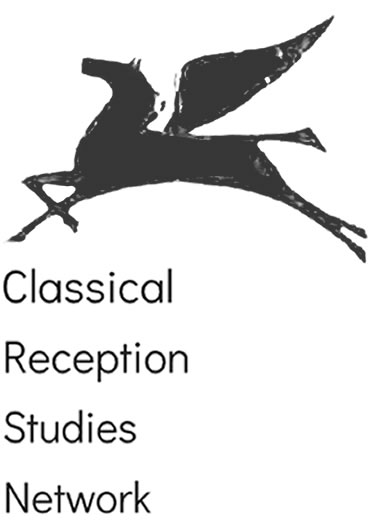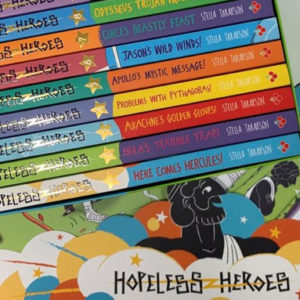In our sixth takeover post we hear from Connie Skibinski, a PhD candidate at the University of Newcastle whose research interests include ancient mythology and classical reception. Connie is currently working with Prof. Marguerite Johnson and Conjoint Prof. Michael Ewans on a thesis examining the portrayal of the Amazon Queen Penthesilea in ancient, early modern and modern literature and art. Connie’s interest in classical literature stretches back as far as she can remember, as she was familiar with the wild and wacky stories of Greek mythology from childhood. In this blog post, Connie interviews the person who introduced her to ancient myths long before she pursued her formal studies in Classics and Ancient History – Stella Tarakson, the author of the ‘Hopeless Heroes’ fiction series, who just happens to be her mother!
Interview with the Author: Stella Tarakson on the ‘Hopeless Heroes’ series
The ‘Hopeless Heroes’ series is not your typical Greek-myth-inspired children’s fiction series. Modern Britain and ancient Greece collide when the 10-year-old Tim Baker accidentally drops an ancient vase which had entrapped Hercules for thousands of years. Released into the modern day, the hero sees no reason why he can’t relive his triumphs in the modern world … but cleaning out a house by diverting a creek through it might not be the best idea.
Despite some hilarious mishaps, the two become firm friends and put their heads together to send the homesick hero back to ancient Greece. When the secret of time travel is revealed to Tim, he can’t resist going back in time to visit his friend. He befriends Hercules’ daughter, and together they encounter Gods, heroes, monsters and even historical figures. This then comes full circle in the tenth and final book, when Gods and heroes erupt into the modern world and chaos ensues. Although quirky and adventurous, an underlying message is taught about what it truly means to be a hero. These books were featured in the Our Mythical Childhood survey, which explores the reception of Classical Antiquity in children’s and young adults’ culture.
I made my mother – I mean, the author – a cup of tea and picked her brain to find out more about her inspiration and writing process. We chatted about how her books blend the ancient and modern worlds in engaging and humorous ways, peppering in educational content and moral lessons along the way.
What inspired you to write this series?
Both of my parents were Greek immigrants, so Greek myths were like Grimm’s fairy tales to me! I learnt many of the stories before I could even read. My parents were keen to pass their language and culture down to their children, and although my language skills could do with some polishing, I’ve inherited a life-long love of mythology. I’ve still got my childhood books and it’s thrilling to think I’ve added to the ever-evolving body of stories.
I didn’t want to do a mere re-telling of the myths – that’s been done many times. Instead, I wanted to create my own unique stories where I combined fictional, modern-day characters with gods, heroes and monsters straight out of Greek mythology.
The series is a tribute to my parents, as well as a vehicle for sharing my love of Greek history and mythology with a wider audience. I’m particularly delighted that I’ve managed to pass this love down to my children, too!
Why do you think classical mythology lends itself so well to children’s fiction?
It works so well because the characters are larger than life, the plots are memorable, and the stakes are high. The stories are so over-the-top, they’re never boring. There’s a reason why they’ve survived for thousands of years! They speak to us about friendship, heroism, and humanity in a way that still resonates today.

I made Hercules a key figure because he is arguably the best-known character from mythology, at least for kids. And yes, I kept the more familiar Roman name, something the publishers were keen on. I studied the 12 labours and considered which would be fun to translate into the modern day – such as confusing a tiger skin rug for the Nemean Lion.
It was challenging to re-imagine the stories for a younger audience, though. There were details I had to skirt around, such as why Hera hated Hercules so much (I merely said she was jealous of his mother). According to the mythology, the goddess drove Hercules mad and he slew his family. This is how he explains it to his young friend Tim: ‘That evil Hera tormented me and never gave me peace. She drove me insane. But then I met my new wife and we had Zoe, and I vowed to keep them safe forever.’ An explanation that is both kid-friendly and the basis for why he became such an over-protective dad, which drives the series’ plot.
Did you try to fit events and characters around true historical time, or were you more flexible?
Well, it’s rather an anachronism stew. The characters and events come from different points of Greece’s history – archaic, classical and mixes within. I even threw in some real historical figures that didn’t exactly live at the same time and in the same place: Socrates, Pythagoras, and Hippocrates. This introduces children to a much broader set of historical and mythical figures than I could otherwise explore if kept true to timelines. It’s far less limiting plot-wise to have access to the full range of historical times – and much more fun!
You also blend the ancient and modern worlds through your characterisations of Greek Gods and heroes. Can you take us through this?
This is one of the ways that I injected humour into the stories. Rather like Horrible Histories, I tweaked ancient figures to give them recognisable modern-day characteristics in a way that stays fundamentally true to the original. For instance, I portrayed Jason as a boat enthusiast, drawing on modern stereotypes of mechanically obsessed car nuts.

Arachne is a rather conniving merchant who sells her woven goods, and Apollo, tired of … ah hem … classical music, has switched to punk.
I must add here that I love Nick’s illustrations. Modern-day characters get the standard cartoon treatment, but the ancient figures are depicted in keeping with black-figure vases. Brilliant!
What sources did you use when researching for your books? We took undergraduate archaeology classes together at the University of Sydney (Australia), how did that content feed into your writing?
There are various conflicting versions of Greek myths, which although confusing, I also found helpful. It gave me the freedom to be flexible and pick the version that best suited my plot. But generally speaking, my main sources were Classical Myth by Powell (Pearson) and the website www.theoi.com.
I loved taking archaeology classes! Once I started writing the series, I found that I needed to learn more about life in everyday ancient Greece. I wanted to know what they wore, what they ate, what their houses were like. I wanted to know more about amphorae: after all, I trapped Hercules in one, then glued it back together and turned it into a time-travelling vessel.
Although I could find information in books and online, I was keen to go back to uni. I did degrees in Economics and Law straight out of high school, but I’ve always been interested in archaeology and jumped at the chance to go back to further study. The fact that my daughter wasn’t embarrassed to have her mum sitting next to her in lectures was a bonus!
How have your books been used as educational resources?
I see my books as a form of ‘teaching by stealth’. Kids learn a lot about ancient Greek history and mythology without actually realising that they are learning. My books were published in the UK, where ancient Greece is studied as part of the curriculum. I know many teachers read the books to their classes to help engage the children and bring the subject to life.
The books have been translated into a few other languages, and in Taiwan they’ve been serialised in an educational magazine. Most recently I’ve been told that they’re being translated into Greek, and I’m so excited! If only my parents were around to see this. I think they’d be very proud – of both of us!

